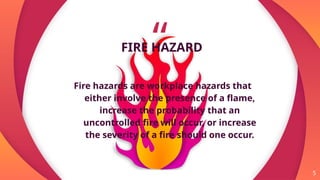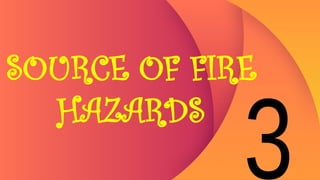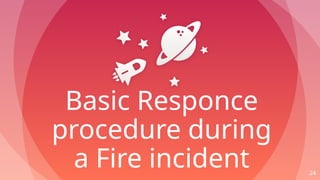CopyY of L8 FIRE HAZARDS LESSON FOR.pptx
- 1. FIRE HAZARDS
- 2. OBJECTIVES/COMPETENCIES 1. Recognize elements of the fire triangle in different situations; 2. Analyze the different causes of fires; 3. Observe precautionary measures and proper procedures in addressing a fire incident; 4. Apply basic response procedures during a fire incident; and 5. Follow fire emergency and evacuation plans; 2
- 3. RECALL!! ANSWER THE FOLLOWING. 1. What are the two (2) parts of a cyclone? What happen to each part? 2. It is a phenomena translated as a boy-child? 3. What are the 3 stages of thunderstorm? 4. Enumerate the three kinds of floods? 5. Give atleast 2 human made cause of 3
- 5. “ FIRE HAZARD Fire hazards are workplace hazards that either involve the presence of a flame, increase the probability that an uncontrolled fire will occur, or increase the severity of a fire should one occur. 5
- 7. ● Fire=Oxygen*Heat*Fuel ● The triangle illustrates the three elements a fire needs to ignite: heat, fuel, and an oxygen ● The fire extinguishes by removing any one of the elements in the fire triangle 7 FIRE TRIANGLE
- 9. ●Cooking equipment ●Kitchen stoves ●Faulty wiring ●Smoking in Bed ●Lighting ●Flammable liquids ●Candles ●Children 9
- 11. Types of fires ●Class A ●Class B ●Class C ●Class D ●Class K 11
- 24. Basic Responce procedure during a Fire incident 24
- 25. Basic Responce The following response procedure was adopted from The University of Chicago Fire Response Plan. It was summarized by the acronym RACER. R – RESCUE: rescue people from the immediate area of smoke and/or fire. Make people aware that there is a fire alarm activation or actual fire within the building. A – ALARM: activate the nearest fire alarm station. When telephone is available call the Police or Fire Department hotlines. (provide details) C – CONTAIN: contain the smoke or fire by closing all windows and doors to rooms, stairways, and corridors. This is to control fire and smoke from spreading. 25
- 26. Basic Responce E – EXTINGUISH: extinguish the fire using the appropriate fire extinguisher for the type of fire being fought. Only attempt to fight the fire if you are comfortable using a fire extinguisher and the fire is small, contained and not spreading beyond the immediate area. R – RELOCATE: relocate to a safe area. When inside the building, relocate outside of the building and away from the main entrance. Do not use elevators within the building as a means of exit. Use the stairways only. *for the sake of enhancement, letter “S” is added to the acronym which stands for: S – SECURE: secure first important documents, money, and heirlooms when fire brakes out inside your own residence. These things are easier to take as you go out from the house than the appliances which can be easily to replaced. 26
- 27. Remember These DOs and DON'Ts ● DO keep items that can catch on fire at least three feet away from anything that gets hot, such as space heaters. ● Smoking materials are the leading cause of residential fire deaths in the United States. So if you smoke: ○ DO take precautions: Smoke outside; choose fire-safe cigarettes; use deep, sturdy ashtrays and douse cigarette and cigar butts with water before disposal. ○ DON'T ever smoke in bed, when drowsy or medicated, or if anyone in the home is using oxygen. ● DO talk to children regularly about the dangers of fire, matches and lighters and keep them out of reach. ● DO turn portable heaters off when you leave the room or go to sleep. ● DO use flashlights when the power is out, not candles. ● DON'T leave a burning candle unattended, even for a minute. 27
- 28. Precautionary Measures and Proper Procedures in addressing a fire incident
- 29. Things to do before the fire ● Install the right number of smoke alarms. Test them once a month and replace the batteries at least once a year. ● Teach children what smoke alarms sound like and what to do when they hear one. ● Ensure that all household members know two ways to escape from every room of your home and know the family meeting spot outside of your home. ● Establish a family emergency communications plan and ensure that all household members know who to contact if they cannot find one another. ● Practice escaping from your home at least twice a year. Press the smoke alarm test button or yell “Fire“ to alert everyone that they must get out. ● Make sure everyone knows how to call emergency hotline. ● Teach household members to STOP, DROP and ROLL if their clothes catch on fire. 29
- 30. If a Fire Starts: ● Know how to safely operate a fire extinguisher ● Remember to GET OUT, STAY OUT and CALL 9-1-1 or your local emergency phone number. ● Yell "Fire!" several times and go outside right away. If you live in a building with elevators, use the stairs. Leave all your things where they are and save yourself. ● If closed doors or handles are warm or smoke blocks your primary escape route, use your second way out. Never open doors that are warm to the touch. ● If you must escape through smoke, get low and go under the smoke to your exit. Close doors behind you. ● If smoke, heat or flames block your exit routes, stay in the room with doors closed. Place a wet towel under the door and call the fire department or 9-1-1. Open a window and wave a brightly colored cloth or flashlight to signal for help. ● Once you are outside, go to your meeting place and then send one person to call the fire department. If you cannot get to your meeting place, follow your family emergency communication plan. 30
- 31. After the fire ● Call 9-1-1 or local emergency hotlines. Give first aid where needed; cool and cover burns to reduce the chance of further injury or infection. ● Let friends and family know you’re safe. ● People and animals that are seriously injured or burned should be transported to professional medical or veterinary help immediately. ● Stay out of fire-damaged homes until local fire authorities say it is safe to re-enter. 31
- 32. Activity In one whole sheet of bond paper, draw an evacuation plan or family escape plan in CASE OF fire incident. (draw based on your house pattern) 32































